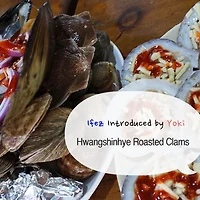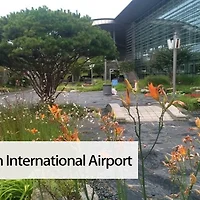The Islands Off Incheon An Ecological Treasure Trove
There are some 130 islands large and small off the coast of Incheon. Every year, over a million people pass through the port of Incheon to visit these islands, where they can find the lifestyles of the past and nature in its original form.
Thus the old islands of Incheon represent its future.
It’s not possible to tell all the stories of the many islands off the coast of Incheon in a single sitting. So, I think it would be helpful to begin with a poem of mine.
On the Geomeunnang coast of Daecheong Isle / The path follows the cliffs into the heavens, / And an old man who will soon return to heaven himself / Has come out to find his last meal on earth. / The old man harvests the oysters clinging clustered to the rocks. / The oysters grow fat and thin with the waxing and waning of the moon. / The island folk also grow fat and thin like the oysters. / The island folk are descendants of the moon. / The moon pushes and pulls the seawater and grows the things of the sea, / And the people go out to the sea to catch the fish and harvest the conches and oysters.
— “Descendants of the Moon” by Kang Je-yoon
Volcanic Island of Gureopdo
“When you arrive at the island, take a moment to slowly look around. You’ll see a landscape that has been changing for tens of thousands of years, sculpted by the wind, waves, fog, and salt air. Things made by human hands are regarded as cultural properties after only a hundred years. Yet people think little of the sculptures created by nature over hundreds of millions of years. They carelessly knock them down in the name of development.”
These words of the captain of the boat to Gureop Island cut to the quick. Gureop Island, part of Deokjeok-myeon, Ongjin County, which administratively belongs to Incheon Metropolitan City, is a tuffaceous island that was created by volcanic activity some 90 million years ago, at the end of the Cretaceous Period of the Mesozoic Era. It was built up from continuous accumulation of volcanic ash. Thus, traces of the volcanic activity and subsequent erosion, as the rocks split apart and crumbled, are still visible along the coast. The island is home to numerous types of animals, including the Eurasian oyster-catcher (Haematopus ostralegus osculans), an endangered species of which there are only 10,000 remaining worldwide, as well as falcons (Natural Monument No. 323), storks, rat snakes, and black water snakes. It also harbors a unique plant community, in which subtropical and subarctic plants can thrive together.
The coastline of Gureop Island is a vivid textbook in geology. The nearby uninhabited Rabbit Island, which is connected with Gureop Island at low tide, is so highly prized for its conservation value that the Cultural Heritage Administration refers to it as “the crowning gem of coastal topography, of a kind found nowhere else in Korea.” Rabbit Island, so named because the residents of Gureop Island once raised rabbits there, has a 20-meter-high coastal cliff pockmarked by tunnels boring 3-5 meters into the cliff side. These tunnels, which were bored not by excavators but created by the saltwater, are the largest sea-eroded ditches in Korea. Also called “notches,” the tunnels are topographical features created by the erosion of volcanic rock due to its exposure to salty seawater over eons of time. Altogether, Gureop Island is a breathtakingly beautiful sculpture park created by nature.
Legendary Fish Market of Yeonpyeongdo
Located near the Northern Limit Line, Yeonpyeong Island is best known these days for being a conflict area, the site of two naval battles between North and South Korea in 1999 and 2002, and an artillery shelling by the North in 2010. It is quite far from Incheon, a distance of 122 kilometers, but only 30 or so kilometers from the North Korean coastal city of Haeju.
With a teeming population of yellow croaker, Yeonpyeong Island was once considered one of the most important islands for fishing. When tens of billions of croakers flocked to the sea around the island, the waters were so abundant with fish that they were said to be “half water and half fish.” Every May, the residents of this island tossed and turned at night to the loud croaking of the schools of fish. During croaker season, a seasonal fish market opened on the island, set up either on land or on the water, depending on the movements of the fish. Thousands of fishing and merchant vessels would descend on the island, cramming the waters to such an extent that it seemed you could walk from one boat to another without getting your feet wet. When the fish market opened, the small, quiet island would be transformed into a bustle of activity, swarming with tens of thousands of residents, fishermen, and merchants. Temporary shops sprang up to sell fishing gear and daily necessities. Also, there were over one hundred bars where more than five hundred barmaids, called “water birds,” served their clients.
In April 1943, when the seasonal fish market was at its peak, some 5,000 boats flocked to the island. In 1944, some 9.7 billion croakers were caught in the waters off the island. And in 1947, the number of fishermen who gathered at the fish market reached 90,000. When the fishing boats arrived, the island women were busy as well. They supplied boats at anchor with food, water, and firewood. They also sold fresh water, lining up on the tidal flats with their water jars. When the fishing season ended, the peddlers quickly packed up and departed, and the island returned to its quietude.
The golden days of Yeongpyeong Island, which seemed as if they would last forever, came to an end in the late 1960s. In 1968, the fishing limit line was drawn north of the island, prohibiting fishing boats from the South to cross it. It was also around this time that the croaker population suffered a drastic decline as a result of years of overfishing. To add insult to injury, around 1969 a cold front began to settle on the Yellow Sea, cooling off the once abundant fishing grounds. The croakers remained in the seas off the south coast of Korea, where fishing boats filled their nets. All this cut off for good the migration of croakers up to Yeonpyeong Island. The croakers that had always been so plentiful vanished without a trace within just a few years. Since fishing boats and merchant vessels stopped visiting the island, the seasonal fish market was finished.
Yeonpyeong Island is wrapped in the tension of division today; if you stand at Manghyang [Homesickness] Observatory on the island, North Korea looks close enough for you to touch.
Mysterious Sand Island of Ijakdo
Ijak Island, located in Jawol-myeon, Ongjin County, used to be called Ijeok Island, which literally means “island of pirates.” It was so-named because the Japanese wako, the most menacing pirates in all of East Asia in ancient times, maintained hideouts on the island. The pirates are long gone, but in the nearby waters is another island that appears and disappears like a mirage. It is a sand island with a surface area of 100,000 square meters or so. Called Puldeung by the locals, it is a mysterious place that hides away at high tide and shows itself at low tide. Stretching 2.5 kilometers east to west and 1 kilometer north to south, this sand bar is like a desert in the middle of the ocean, a sight that could only be the work of God.
In the past, people said, you could easily catch blue crabs, shrimps, halibut, and other creatures that got stranded in the tidal pools on Puldeung during low tide. Long a spawning ground for various sea creatures, Puldeung was a vital food source for the residents of Ijak Island for generations. However, the county of Ongjin authorized the gathering of sand from here for over 10 years. As a result, much of the sand has been removed, and only about 100,000 square meters of the original 165,000-square-meter sand bar remains. Admonished by local residents and environmental groups, the government belatedly realized the scenic and ecological value of Puldeung and in 2004 designated it an “ecological conservation zone.” The residents of Ijak Island now understand the value of Puldeung and are taking the lead in its preservation.
On Ijak Island’s Jageun Puran Beach sits the oldest rock in Korea, formed over 2.5 billion years ago. It is a migmatite formed when a metamorphic rock partially melts and recrystallizes into an igneous rock. The result is a mixture of metamorphic rock and igneous rock, which is an important clue in explaining the evolution of the earth’s crust on the Korean Peninsula.
Billion-year-old Fossils on Socheongdo
Socheong Island is a tiny island that takes only a couple of hours to tour at a leisurely pace. On its southeastern shore is a marble cliff that the locals call Powdered Rock. Marble is formed by the metamorphosis of limestone, and when the surface erodes it takes on a powdery appearance, hence the local name. Near this cliff are the oldest stromatolite fossils in Korea. They are the fossils of cyanobacteria (blue-green algae) that were formed one billion years ago during the Neoproterozoic Era. Cyanobacteria were the first primitive microorganisms on earth to use photosynthesis, some two billion years ago. They were the first organisms to create oxygen and enabled the emergence of other life forms on earth.
There have been reports of stromatolites formed two billion years ago in North Korea, but of the fossils found in South Korea, these are the oldest, constituting natural heritage of immense geological value. But the fossils have been seriously damaged in the 20th century. Up to the early 1980s, many of them were taken and crafted into products that made use of their patterns. It was only in 2009 that they were designated Natural Monument No. 508. It is fortunate that their value has been recognized, although belatedly, and they are now being protected.
‘The Last Work of an Old God,’ Baengnyeongdo
Baengnyeong Island is located far north, along the coast of North Korea’s Hwanghae Province, lying closer to Pyongyang than to Seoul. Passenger boats traveling to this island from South Korea must sail beyond the islands of North Korea’s Ongjin County (Sunwi, Ohwa, Changnin, Piam, Kirin, and Maam Islands) and Changyon County (Wollae, Yuk, and other islands), and continue northward. For a long time, Baengnyeong Island was part of Changyon County of Hwanghae Province, but when Korea was divided it came under the jurisdiction of Ongjin County, which now belongs to Incheon Metropolitan City. Although it is 229 kilometers from Incheon, it is only 13.5 kilometers from Changsan Point in North Korea.
Baengnyeong Island, which faces Changsan Point of North Korea across the water, is famed for the rock formations of Dumujin, found at the island’s northwestern tip. In the waters off the coast of Dumujin stand row upon row of rock formations, such as the Brother Rocks, Elephant Rock, Candlestick Rock, and Immortal Rock. Because they bring to mind the fantastic shapes of Mt. Kumgang (or Diamond Mountains, also spelled “Geumgang”), this area is called the “Mt. Kumgang of the West Sea.” Yi Dae-gi, who led volunteer troops to fend off Japanese invaders at the end of the 16th century, was exiled to this island near the end of his life. He was fascinated by the scenery of Dumujin and, in his records of his life in exile, he called this place “the last work of an old god.” Yet Dumujin, with all its natural beauty, served as a base for marauding pirates for a long time.
There are three predators in the seas off the Dumujin coast: seals, cormorants, and humans. The spotted seals, which migrate during the winter breeding season to the icy waters of Liaodong Bay in the Bohai Sea, return to Dumujin in the spring. These seals that could be seen anywhere in the West Sea in the past are now an endangered species. In the waters off Dumujin, the seal’s sole competitor is the cormorant. The cormorants build their nests in the rocky cliffs and can dive to depths of 40 meters to catch fish.
This island has always been a site of military tension, located as it is near the North-South border, but recently the winds of peace have been blowing. This is due to the Baengnyeong Island Peace Arts Residency, operated by the Incheon Art Platform (an affiliate of the Incheon Foundation for Arts and Culture) to support the creative activities of and promote exchanges between artists from Korea and abroad. Under this initiative, artists from Korea as well as the United States, China, and many other nations are using the island as a base for their creative activities, against the backdrop of the sea of division. There is no doubt that their activities will contribute to the easing of tension.
Kang Je-yoon (Poet; Principal, Island School)
Publisher : Korea Foundation
source : Koreana http://www.kf.or.kr








